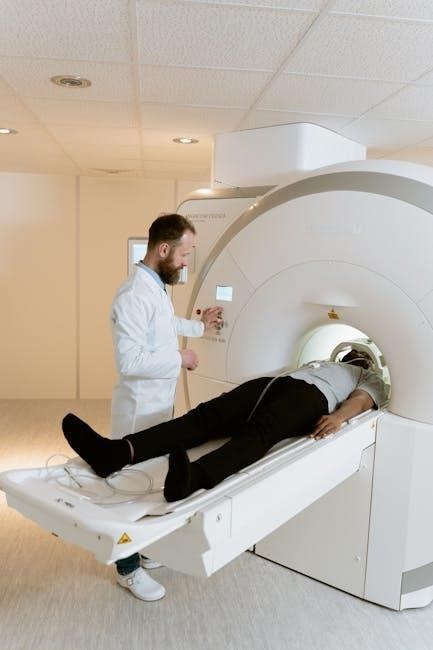The Novice 27 dressage test is a cornerstone for developing riders and horses, focusing on refining fundamental skills in a structured pattern. Designed to assess balance, harmony, and clear communication between horse and rider, it serves as a bridge to higher-level competitions. Judges evaluate the horse’s ability to perform precise movements with ease and the rider’s ability to guide seamlessly. This test emphasizes the importance of proper training and preparation, making it a vital step in the dressage journey.
- Assesses fundamental dressage skills in a progressive manner.
- Focuses on balance, harmony, and clear communication.
- Prepares riders and horses for advanced competitions.
By mastering the Novice 27 test, riders demonstrate their readiness to advance in the sport, showcasing both technical proficiency and artistic expression.
Overview of the Test
The Novice 27 dressage test is a standardized pattern designed to evaluate the horse’s obedience, balance, and responsiveness to the rider’s aids. It incorporates foundational movements such as walk, trot, and canter, along with transitions and circles, to assess the horse’s ability to perform with precision and harmony. The test is typically ridden in a 20×40-meter arena and serves as a progression from introductory levels, preparing riders for more complex movements in higher-level tests. The USEF provides official PDF resources for competitors to study and master the test requirements effectively.
Importance of the Novice 27 Test in Dressage Training
The Novice 27 test plays a pivotal role in dressage training by refining foundational skills and building a strong partnership between horse and rider. It bridges the gap between introductory and advanced levels, ensuring horses develop the balance, suppleness, and responsiveness needed for higher-level movements. Riders benefit by enhancing their ability to communicate clearly and guide their horses through precise patterns. This test is essential for competitors aiming to progress in eventing and pure dressage, as it solidifies the fundamentals required for success in more challenging competitions.

Key Movements and Requirements of the Novice 27 Test
The Novice 27 test emphasizes smooth transitions, accurate geometry, and consistent rhythm. Key movements include serpentines, small circles, and lengthened gaits, requiring balance and harmony.
Breakdown of the Test Pattern
The Novice 27 test pattern is carefully designed to assess a horse’s obedience and a rider’s ability to navigate precise movements. The test begins with a formal entry and proceeds through a series of serpentines, small circles, and changes of direction. Riders execute transitions between working trot, canter, and walk, demonstrating smoothness and control. The pattern also includes lengthened gaits, highlighting the horse’s ability to extend its stride while maintaining rhythm. Accurate riding and clear communication are essential for success.
- Includes serpentines, small circles, and changes of direction.
- Transitions between trot, canter, and walk are key.
- Lengthened gaits test the horse’s ability to extend stride.
- Accuracy and clear communication are critical.
This structured pattern evaluates the horse’s balance, harmony, and responsiveness to the rider’s aids.
Key Movements and Their Execution
The Novice 27 test emphasizes precise execution of foundational movements, including serpentines, small circles, and transitions. Riders must maintain balance and rhythm, ensuring smooth execution of each movement. serpentines require fluidity and symmetry, while small circles test the horse’s ability to bend and maintain pace. Transitions between gaits must be seamless, demonstrating clear communication between horse and rider. Proper use of aids and consistent tempo are critical for high scores.
- Serpentines demand fluidity and symmetry in movement.
- Small circles test the horse’s balance and bend.
- Transitions between gaits must be smooth and well-timed.
- Consistent rhythm and tempo are essential for success.
Scoring Criteria for Each Movement
Judges evaluate each movement based on clarity of aids, balance, and fluidity. Precision in executing serpentines, circles, and transitions is critical. The horse’s willingness and the rider’s ability to maintain rhythm and tempo significantly impact scores. Each movement is scored on a scale, with deductions for errors like loss of balance or poor geometry. Consistency and harmony between horse and rider are key to achieving higher marks, as judges reward seamless communication and precise execution of the test pattern.
- Clarity of aids and balance are essential for high scores.
- Serpentines and circles are judged on precision and symmetry.
- Transitions must be smooth and well-timed.
- Consistency and harmony enhance overall scoring.
Understanding the Scoring System
The scoring system evaluates horse and rider performance based on predefined criteria. Judges assess balance, rhythm, and the horse’s willingness to respond to aids. Errors in execution lower scores, while precision and harmony increase them. The system aims to objectively measure the partnership’s progress and readiness for higher levels of competition.
- Judges score based on balance, rhythm, and responsiveness.
- Errors in execution reduce scores significantly.
- Precision and harmony are key to higher marks.
- The system measures the horse-rider partnership’s progress.
How Judges Evaluate the Test
Judges evaluate the Novice 27 test by assessing the horse’s balance, rhythm, and responsiveness to aids. They score each movement based on its execution, harmony, and the horse’s willingness to perform. The judge looks for precise transitions, correct geometry, and smooth communication between the rider and horse. Errors in movement execution or loss of rhythm result in lower marks, while seamless performance and clear understanding between the pair earn higher scores. The evaluation emphasizes the partnership’s ability to demonstrate clarity and precision throughout the test pattern;
- Balance and rhythm are critical for high scores.
- Errors in movement execution lower marks significantly.
- Harmony and smooth communication are essential.
- Judges prioritize clarity and precision in performance.
Common Marks and Deductions
In the Novice 27 test, common deductions include errors in geometry, poor transitions, and loss of rhythm. Judges may lower marks for incorrect movements or lack of balance. High marks are awarded for seamless execution, harmony, and clear communication between the horse and rider. Deductions are also made for excessive aids or resistance from the horse, emphasizing the importance of precision and partnership. Understanding these criteria helps riders focus on improving specific areas to achieve higher scores.
- Errors in geometry or transitions result in lower scores.
- Loss of rhythm or balance leads to deductions.
- Excessive aids or horse resistance penalize performance.
- Harmony and precision earn higher marks.
Equipment and Arena Setup
The Novice 27 test requires a standard 20×40-meter dressage arena with precise markings, including letters and cones. Riders must use approved dressage tack, including a saddle, bridle, and bit, while wearing appropriate attire such as a helmet, riding boots, and breeches. The horse must be properly groomed and equipped according to USEF regulations to ensure safety and fairness during the test.
- Standard 20×40-meter arena with specific markings.
- Dressage tack, including saddle, bridle, and bit.
- Riding helmet, boots, and breeches required.
- Horse must be well-groomed and properly equipped.
Required Tack and Attire
The Novice 27 test mandates specific equipment and dress code for safety and professionalism. Riders must wear a properly fitted helmet, riding boots, and breeches. The horse requires a dressage saddle, bridle with a snaffle or double bridle, and a properly fitted bit. Spurs and whips are allowed but must adhere to USEF regulations. Attire should be neat and traditional, reflecting the formal nature of dressage competitions. Correct tack ensures comfort and clarity in communication between horse and rider.
- Dressage saddle and bridle with snaffle or double bridle.
- Helmet, riding boots, and breeches for riders.
- Spurs and whips must meet USEF guidelines.
- Traditional, neat attire required.
Arena Dimensions and Markings
The Novice 27 test is performed in a standard dressage arena measuring 20 meters by 40 meters. The arena is marked with letters A-H along the long sides and letters E-B on the short sides. The centerline runs diagonally, dividing the arena into two halves. Accurate placement of these markings ensures precise execution of movements. Riders enter at A, salute at X, and perform movements aligned with these letters, maintaining clarity and precision throughout the test.
- Arena size: 20m x 40m.
- Letters A-H on long sides, E-B on short sides.
- Centerline and quarterlines guide movement execution.

Training Tips for Mastering the Novice 27 Test
Focus on consistent practice, clear communication, and precise execution of movements. Regularly review the test pattern to ensure accuracy and fluidity in performance. Incorporate video analysis to identify and improve weak areas, ensuring the horse is responsive and balanced throughout the test. Breaking the test into sections for focused practice can enhance overall mastery and confidence.
- Practice movements in sections for clarity.
- Use video feedback to refine performance.
- Ensure the horse is balanced and responsive.
Preparing the Horse for the Test
Consistent training and a well-structured routine are essential for preparing the horse. Focus on building the horse’s strength, balance, and obedience to commands. Regular practice of the test pattern helps the horse become familiar with the sequence of movements. Incorporate exercises that improve the horse’s flexibility and responsiveness, ensuring smooth transitions between movements. Mental preparation is equally important, as a calm and focused horse performs better. Regular schooling sessions and positive reinforcement can enhance the horse’s confidence and readiness for the test.
- Establish a consistent training routine.
- Practice test movements to build familiarity.
- Focus on strength, balance, and obedience.
Rider Tips for Improving Performance
To excel in the Novice 27 test, riders should focus on clear communication with their horse through subtle aids. Practice the test pattern repeatedly to ensure accuracy and fluidity. Maintain a calm and composed demeanor to help the horse stay focused. Engage the horse’s hindquarters for better balance and impulsion. Regularly review and refine movements under the guidance of a trainer to address weaknesses. Consistent practice and attention to detail will enhance overall performance and confidence in the arena.
- Use subtle aids for clear communication.
- Practice test patterns for accuracy.
- Maintain a calm and composed demeanor.
- Engage the horse’s hindquarters for balance.
Common Mistakes and How to Avoid Them
- Rushing transitions can lead to loss of balance and precision.
- Inaccurate geometry in movements like circles and serpentines.
- Insufficient engagement from the horse’s hindquarters.
Typical Errors in Execution
Common mistakes in the Novice 27 test include rushing transitions, inaccurate geometry, and insufficient engagement. Riders often misjudge the size of circles or fail to maintain consistent pace. Incorrect alignment during serpentines and inadequate preparation for changes of direction are frequent issues. Additionally, horses may show resistance or stiffness, leading to loss of suppleness. Overlooking proper alignment at the final centerline can also result in lower scores. Addressing these errors requires meticulous practice and a focus on precision and harmony.
- Rushing transitions disrupts rhythm and balance.
- Inaccurate geometry affects movement execution and alignment.
- Lack of engagement reduces the horse’s ability to perform smoothly.
Strategies for Minimizing Mistakes
To minimize errors in the Novice 27 test, focus on precise preparation and execution. Practice the test pattern repeatedly to ensure accuracy in geometry and timing. Use visualization techniques to mentally rehearse each movement, enhancing focus and consistency. Break the test into sections, mastering one movement at a time before combining them. Incorporate exercises that improve the horse’s suppleness and responsiveness to aids. Regularly review videos of your performances to identify and correct flaws. Clear communication and calm demeanor are key to a polished performance.
- Practice test patterns to ensure accuracy in geometry and timing.
- Use visualization to mentally rehearse each movement.
- Master one movement at a time before combining sections.
- Incorporate suppleness exercises for better responsiveness.
- Review performance videos to identify and correct flaws.

Video Resources and Analysis
USEF-Approved Videos for Study
USEF offers official Novice 27 test videos, providing visual guides for understanding movement execution and scoring. Riders can access these resources to refine their techniques and gain insights into judge expectations.
- USEF-approved videos demonstrate correct movement execution.
- EN readers can use promo code ENLRK3DE for free access.
- Videos help riders understand judge scoring criteria.
USEF provides official Novice 27 dressage test videos, offering clear visual guides for riders to study and improve. These resources are essential for understanding proper movement execution, scoring criteria, and judge expectations. EN readers can access these videos for free using the promo code ENLRK3DE. The videos feature expert commentary, highlighting key elements such as balance, harmony, and precision. By analyzing these approved videos, riders can refine their techniques and gain a deeper understanding of the test requirements, ultimately enhancing their performance in competitions.
- Official USEF videos demonstrate correct test execution.
- EN promo code ENLRK3DE offers free access to videos.
- Expert commentary highlights key performance aspects.
How to Analyze Your Own Test Videos
Start by reviewing your Novice 27 test video to identify strengths and areas for improvement. Pay attention to your posture, alignment, and the horse’s balance. Compare your performance to USEF standards and note any deviations in movements. Focus on specific patterns like transitions, circles, and halts. Use slow-motion to assess precision and fluidity. Track progress over time to measure improvement. Consider seeking professional feedback to refine your technique and achieve higher scores in future competitions.
- Review posture, alignment, and balance in movements.
- Compare performance with USEF dressage standards.
- Identify and correct deviations in specific patterns.
- Use slow-motion to assess movement precision.
- Track progress and seek professional feedback.
The Role of the Novice 27 Test in Eventing
The Novice 27 test is a foundational step in eventing, evaluating key skills that prepare horses and riders for higher-level competitions and essential future challenges.
Significance in Eventing Competitions
The Novice 27 dressage test plays a pivotal role in eventing, serving as a foundational assessment of a horse’s balance, obedience, and responsiveness. These qualities are crucial for success in both cross-country and show jumping phases. By mastering the test, riders demonstrate their ability to navigate complex challenges, ensuring their horse is prepared for the demands of eventing. This test is often a stepping stone for competitors aiming to progress to higher levels, making it a cornerstone in the development of eventing skills.
Progression to Higher Levels
Mastery of the Novice 27 test marks a significant milestone, enabling riders to transition smoothly to more advanced competitions. The skills honed in this test, such as precise movements and clear communication, form the foundation for higher-level dressage. Riders who excel at this stage often move on to training and preliminary levels, where technical difficulty increases. The Novice 27 test serves as a crucial stepping stone, preparing horses and riders for the challenges of advanced dressage and eventing.
- Builds foundational skills for advanced competitions.
- Prepares for increased technical demands in higher levels.
- Enhances horse-rider harmony and precision.
Success in the Novice 27 test is a testament to effective training and readiness for the next phase of competitive dressage.
and Further Resources

Rules and Updates from USEF
USEF regularly updates dressage tests, with the Novice 27 test revised in 2021 to reflect current standards. Riders must use the latest PDF version for competitions, ensuring compliance with rule changes and improvements for fair evaluation across all levels.
Access the official USEF guidelines here
